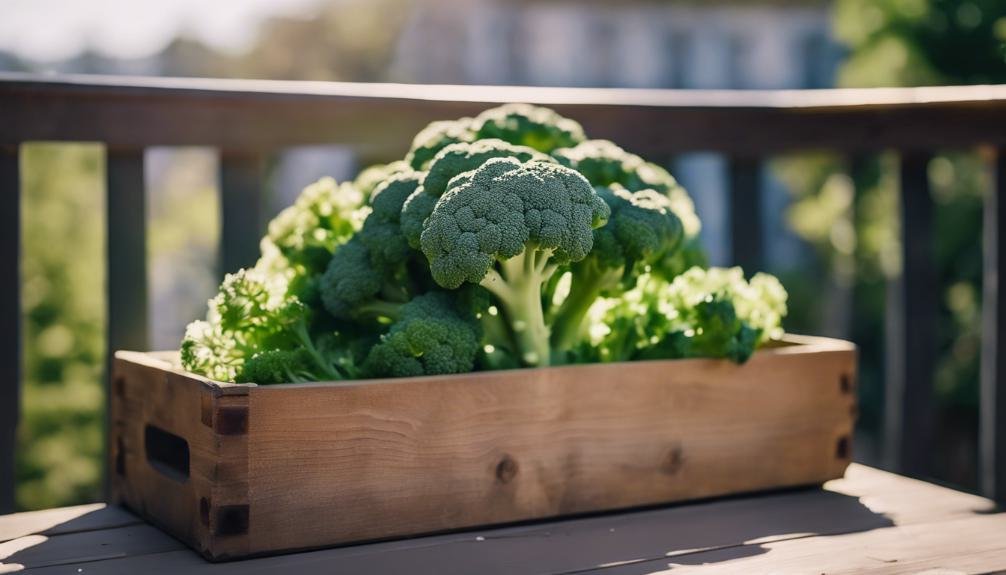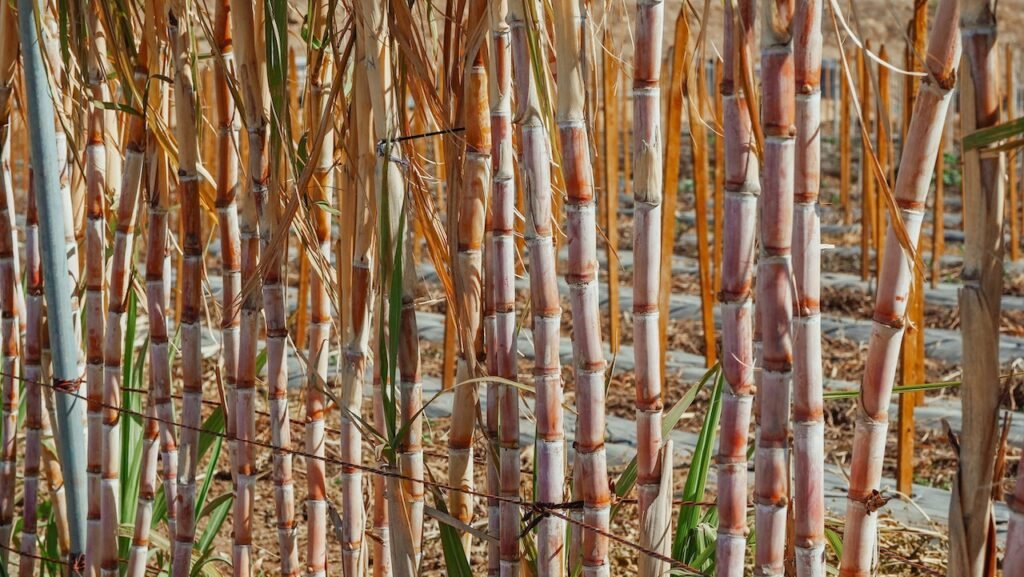Broccoli’s exceptional nutritional value and adaptability to container growing make it an ideal crop for gardeners of all levels. To guarantee a bountiful harvest, select a container with adequate depth and width, providing sufficient space for broccoli’s extensive root system. Sow seeds indoors 6-7 weeks before the last frost date, and transplant seedlings when they have 2-3 sets of leaves. Maintain well-draining, fertile soil with a pH between 6.0 and 7.0, and provide full sun with at least six hours of direct sunlight per day. By following these guidelines, you’ll be well on your way to a thriving broccoli container garden, and with further attention to detail, you can tap the full potential of this nutritious crop.
Key Takeaways
- Choose a container with a minimum depth and width of 12-18 inches to provide adequate root space and support for broccoli.
- Sow broccoli seeds indoors 6-7 weeks before the last frost date, and transplant seedlings when they have 2-3 sets of leaves.
- Maintain well-draining, fertile soil with a pH between 6.0 and 7.0, and fertilize with a balanced fertilizer once a month.
- Provide full sun with at least six hours of direct sunlight per day, and maintain consistent moisture with regular watering.
- Harvest broccoli when the central head is compact and tight, and remove any yellowing leaves or signs of pest damage to maintain a healthy plant.
Understanding Broccoli Basics

Before delving into the specifics of container growing, it is essential to understand the basics of broccoli, including its varieties, growing requirements, and characteristics.
Broccoli has a rich history, originating from Italy over 2,000 years ago.
Today, it is a popular crop globally, prized for its exceptional nutritional value.
Broccoli is an excellent source of vitamins C and K, fiber, and antioxidants, making it a valuable addition to a healthy diet.
With its cool-season crop requirements, broccoli thrives in temperatures between 65-75°F (18-24°C) and full sun.
Understanding these fundamental aspects of broccoli will provide a solid foundation for successful container growing.
Selecting the Right Container
When cultivating broccoli in containers, a minimum depth and width of 12-18 inches is essential to provide adequate root space and support for the plant’s mature size.
Container materials play a pivotal role in broccoli growth, with plastic pots being lightweight and retaining moisture well, but prone to brittleness over time. Clay and ceramic pots offer good insulation, but tend to dry out faster.
Fabric pots, on the other hand, promote healthy root development and prevent overwatering. Pot size considerations are also indispensable, as broccoli requires sufficient space to accommodate its extensive root system.
A larger container will provide a more stable environment, allowing the plant to thrive. By selecting the right container, broccoli growers can guarantee ideal growing conditions and maximize yields.
Sowing Seeds and Transplanting

With the right container in place, attention can now shift to sowing broccoli seeds or transplanting seedlings, a vital step in the broccoli container growing process.
For seed starting, plant broccoli seeds indoors 6-7 weeks before the last frost date. This allows for a 70-100 day maturation period, ideal for broccoli’s cool-season growth.
Once seedlings have 2-3 sets of leaves, it’s time for transplanting. Verify potting mix is thoroughly watered before transplanting, and create a hole deep and wide enough for the seedling’s roots. Firmly press soil around the base to secure the seedling.
Transplant timing is pivotal, as broccoli prefers to mature in cooler weather. By following these steps, you’ll be well on your way to a thriving broccoli container garden.
Caring for Your Broccoli
Proper care is essential to promote healthy growth and maximize yields in broccoli container gardens.
Soil conditions play a critical role in broccoli growth, and it’s pivotal to maintain well-draining, fertile soil with a pH between 6.0 and 7.0.
Companion planting can also be beneficial, as certain plants like onions, garlic, and herbs can help deter pests and improve soil health.
Regular fertilization with a balanced fertilizer is also necessary to support healthy growth.
Additionally, monitoring for pests and diseases is essential to prevent infestations and infections.
Light, Temperature, and Water

Broccoli plants require specific environmental conditions to thrive, including ideal light, temperature, and watering regimens that cater to their unique needs.
Broccoli prefers cooler temperatures, between 65-75°F (18-24°C), making it suitable for cooler climates.
Provide full sun, with at least six hours of direct sunlight per day, and avoid hot weather to prevent bolting. For indoor containers, place them near a south-facing window or supplement with grow lights.
Establish a consistent watering schedule, checking soil moisture regularly and watering if the top inch of soil feels dry. Avoid overwatering, which can lead to root diseases.
Harvesting and Pruning Tips
Timing the harvest correctly is essential, as broccoli buds rapidly shift from tender and flavorful to tough and fibrous once they reach maturity.
For a fresh harvest, wait until the central head is compact and tight, then cut it at an angle, leaving about 5 inches of stem intact. This will encourage side shoots to grow, providing a bountiful yield.
Regular pruning is also pivotal, as it promotes healthy growth and prevents disease. Remove any yellowing leaves or signs of pest damage to maintain a healthy plant.
Managing Pests and Diseases

Effective pest and disease management is crucial in container-grown broccoli, as these issues can quickly spread and devastate the entire crop. Regular monitoring is essential to identify potential problems early on. Common pests affecting broccoli include aphids, whiteflies, and spider mites, while diseases like club root and downy mildew can also occur.
| Pest/Disease | Management Strategy |
|---|---|
| Aphids | Companion planting with onions, garlic, and herbs; neem oil applications |
| Club root | Improving soil drainage, avoiding overwatering, and crop rotation |
| Spider mites | Insecticidal soap applications, introducing natural predators |
Implementing these strategies can help prevent infestations and infections, ensuring a healthy and productive broccoli crop. By being proactive and vigilant, container gardeners can minimize the risk of pest and disease issues and enjoy a successful harvest.
Broccoli Container Garden Care
Properly maintaining a broccoli container garden requires a delicate balance of moisture, nutrients, and pest management to promote healthy growth and maximize yields.
Regular watering is vital, as broccoli plants need consistent moisture, especially when producing buds. Verify the top 1-2 inches of soil feel dry to the touch before watering.
Fertilize with a balanced fertilizer once a month to provide essential nutrients.
Maintain fresh soil by repotting every 2-3 weeks, and remove any dead or dying plant material to prevent disease spread.
Encourage healthy foliage by providing adequate sunlight and pruning regularly to promote air circulation.
Frequently Asked Questions
Can I Grow Broccoli in a Container on a Balcony With Partial Shade?
When growing broccoli on a balcony with partial shade, consider the balcony microclimate and shade tolerance. While broccoli prefers full sun, some varieties can tolerate partial shade. Choose a shade-tolerant variety like ‘Purple Sprouting’ and guarantee the container receives at least 4 hours of direct sunlight.
How Often Should I Rotate My Broccoli Container to Ensure Even Growth?
To guarantee even growth, rotate your broccoli container every 2-3 days to maintain ideal broccoli orientation, leveraging container mobility to expose all sides to sunlight and promoting balanced development.
Can I Use Self-Watering Containers to Reduce Watering Frequency?
Self-watering containers can be beneficial for broccoli growth, as they maintain consistent moisture levels, reducing watering frequency and conserving water. However, guarantee the container’s water reservoir doesn’t overwater, as broccoli prefers well-draining soil to prevent root diseases.
Will Broccoli Plants in Containers Attract Pollinators Like Bees?
Broccoli plants in containers can attract pollinators like bees, particularly with bee-friendly varieties. Incorporating a diverse range of pollinator-friendly plants nearby can enhance pollinator diversity, supporting the local ecosystem and potentially improving broccoli yields.
Can I Reuse Potting Mix From a Previous Broccoli Harvest?
When reusing potting mix from a previous broccoli harvest, it’s vital to verify a Fresh Start by performing Soil Sterilization to eliminate potential pathogens and pests, guaranteeing a healthy environment for your new broccoli crop.


